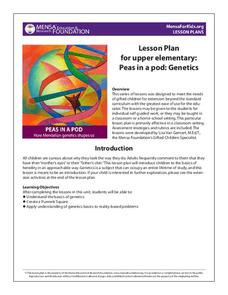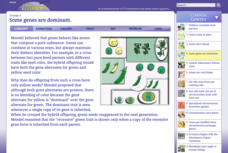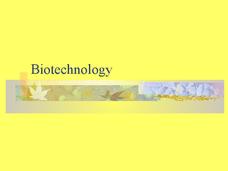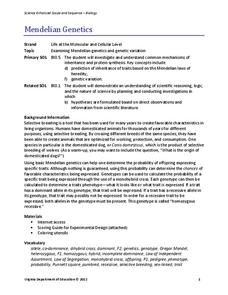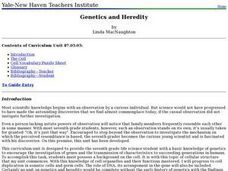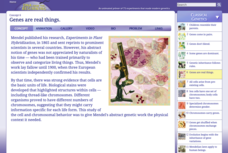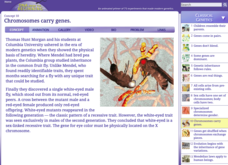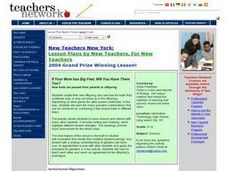Biology Junction
Mendelian Genetics
Over the course of seven years, Gregor Mendel grew more than 28,000 pea plants. The large amount of data he collected led him to postulate the rules of genetics as we understand them today. Scholars learn about Mendel, genetics, and...
US National Library of Medicine
Monster Genetics Lab
Harness young scientists' knowledge of genetics with an engaging science activity. Students start by flipping a coin to determine the genotypes and phenotypes of two parent monsters, before using Punnett squares to...
MENSA Education & Research Foundation
Peas in a Pod: Genetics
Can peas have grandparents? Learn about inherited traits and heredity with a set of activities focused on Mendelian genetics. As your class learns about the process of passing traits along in Punnett squares, they take on the role of...
Science 4 Inquiry
Genetics, Genetics, and More Genetics: Exploring Independent Assortment and Non-Mendelian Genetics
Two individuals share 99.9 percent of their genetic codes, yet diversity is observed everywhere. Young scientists learn about diversity through hands-on activities and an experiment. They apply the concepts of independent assortment and...
Science 4 Inquiry
Monster Mash-Up of Genetics
It's alive! Young mad scientists create monsters as they explore the probabilities of genetic traits during a well-structured inquiry lesson. Pairs travel from station to station, rolling the dice and adding traits to their creations as...
Virginia Department of Education
Mendelian Genetics
How did Mendel know which pea plants would demonstrate certain characteristics? Pupils explore the answer this question, among others, as they complete Punnet squares, research dominant and recessive traits, and explore hereditary...
Texas A&M University
Genetics Using Punnett Squares
Gregor Mendel was a monk who failed his teaching certification exam. He then dedicated his life to science and ended up creating the field of genetics. This presentation introduces the concepts of genetics and Punnett squares.
American Museum of Natural History
A Nature and Nurture Walk in Mendel Park
We are what we make of ourselves ... sometimes. Learners play a game to come up with the answer to a riddle. The game consists of determining whether different scenarios are due to nature or nature and nurture. With each correct answer,...
Cold Spring Harbor Laboratory
Some Genes Are Dominant
Dominate a lesson on genetic traits. Young scholars learn about the difference between dominant and recessive traits with an interactive lesson. An animation demonstrates Mendel's work on the inheritance of traits, and interactive...
Curated OER
Basic Introduction to Foundation of Life: Genes, Genetics and Genetic Diseases
Students are introduced to genetics along with genetic diseases and heredity. In groups, they complete a Punnett Square to determine the dominant and recessive genes. After viewing diagrams, they identify the characteristics of DNA and...
Curated OER
Peas In A Pod: Mendelian Genetics
Students complete a series of lessons where they learn about the basics of genetics, fill out Punnett Squares correctly, and solve reality based problems. In this genetics lesson plan, students have worksheets that are provided.
Curated OER
What is Genetics?
In this biology worksheet, 9th graders identify which seed color is dominant in the given chart and explain why it is. Then they create a Punnett square showing the alleles of the parent plants and first generation of offspring.
Curated OER
Mendel and Meiosis
In this meiosis worksheet, students review vocabulary words associated with genetics, fertilization, heredity, phenotype and genotype. This worksheet has 6 matching and 9 fill in the blank questions.
Curated OER
Biotechnology
A continuous cascade of information comes through this PowerPoint on biotechnology. The topic is defined, a history is presented, and basic genetic engineering techniques are explained. The topic is covered in an objective manner,...
Curated OER
Genetics Since Mendel
In this biology learning exercise, 9th graders describe how two alleles can produce three phenotypes. Then they create a Punnett square showing the possible offspring of red and white cattle. Students also determine the genotypes and...
Curated OER
Guess Who Came to Dinner!
An exceptionally creative approach is taken to assessing your biologists' grasp of natural selection concepts. They are to imagine hosting Charles Darwin for dinner and having, to their surpise, a few other noted scientists crash the...
Curated OER
Mendelian Genetics
Students work collaboratively in small learning groups to create some representation of an aspect of Mendelian genetics in this review instructional activity for the Biology classroom. The instructional activity includes task cards for...
Curated OER
Biology: Genetics and Heredity
Seventh graders explore the connection between genetics and heredity by examining the cellular structure. Among the numerous activities to engage students are drawing DNA molecules, vocabulary puzzle sheets, and predicting possible...
Cold Spring Harbor Laboratory
Genes Are Real Things
Proving microscopic structures exist is a difficult task. Learn how scientists did just that in the mid-1800s as they set out to identify the cellular structures related to genetics. The online lesson explains the collection of work that...
Curated OER
A Look Into the Past
Students practice looking at their genetics to inquire about their past. In groups, they determine their recessive and dominant genes and plot their height on a graph. They compare and contrast the processes of meiosis and mitosis. ...
Curated OER
Evolution of Biotechnology Timeline
Students explore how present biotechnology has evolved. They create a timeline is included referencing major scientists and major events in history which have led to our current understanding and use. A teacher time line is included.
University of Georgia
Monohybrid Crosses and The Punnett Square Lesson Plan
Looking for a quick, hands-on activity to teach young scientists about Punnett squares through monohybrid crosses? then check out this one.
Cold Spring Harbor Laboratory
Chromosomes Carry Genes
Some traits only exist in males and some only in females. Pupils learn how the location of genes on sex chromosomes determines them using an interactive lesson. An animation illustrates how scientists know this to be true and shows how...
Curated OER
If Your Mom Has Big Feet, Will You Have Them Too?
Learners describe and apply the Mendellian principles of genetics, focusing predominantly on dominant and recessive genes. They demonstrate how two parents contribute genes and how those genes appear in their offspring. They describe...




